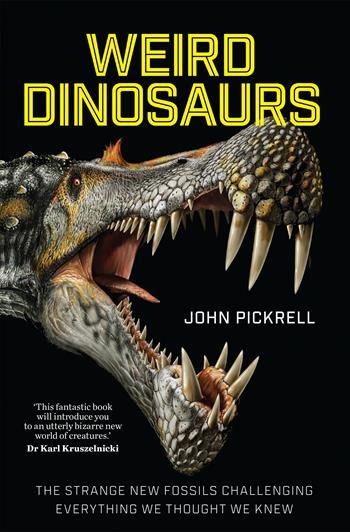How Do We Know What Dinosaurs Really Looked Like?
“When faced with new fossils today, palaeontologists have a much bigger body of knowledge to draw upon when creating reconstructions. In fact, our knowledge has increased to the degree that – somewhat miraculously – we can tell the colours of the dinosaur feathers of a range of species.” — John Pickrell
This week, our featured book is Weird Dinosaurs: The Strange New Fossils Challenging Everything We Thought We Knew, by John Pickrell, with a foreword by Philip Currie. Today, we are happy to provide a short excerpt from an article written by John Pickrell for Science Focus, the online home of BBC Focus Magazine, where you can read the article in full.
How Do We Know What Dinosaurs Really Looked Like?
By John Pickrell
We take reconstructions of dinosaurs for granted these days, but just how realistic are they, and how do we know what dinosaurs really looked like?
When ancient people were faced with strange bones, they did exactly what we do today, and used the best knowledge available to reconstruct the creatures that left them behind. Sometimes this resulted in poor conclusions. The first name assigned in print to any dinosaur remains was the ignominious title of Scrotum humanum – a label given by British physician Richard Brookes to the broken end of a femur in 1763, believing it to be the fossilised testicles of a Biblical giant.
We now know that the leg bone belonged to a Megalosaurus – correctly described as an extinct reptile by William Buckland in 1824. You can’t entirely blame Brookes for his conclusions, as dinosaurs would not be described as a group until 1842. That was when Richard Owen, head of what is now the Natural History Museum, revealed to the world a new class of strange, extinct creatures he called dinosaurs, meaning ‘fearfully great reptiles’. He imagined Iguanodon, Megalosaurus and Hylaeosaurus to be reptiles with legs sprawled out to the sides, with scaly grey or green skin: something like modern lizards or crocodiles.
…
Over time, we have come to completely revise our understanding of the appearance of dinosaurs, and much of this began with the description of another American dromaeosaur called Deinonychus in the 1960s. John Ostrom at Yale University made the revolutionary suggestion that this species was a bird-like, fast, warm-blooded pack hunter, and so began the ‘dinosaur renaissance’ of the 1960s and 70s. Ostrom championed the idea that birds were dinosaurs, and was spectacularly vindicated when Sinosauropteryx, the first known feathered dinosaur, was found in China in 1996.
When faced with new fossils today, palaeontologists have a much bigger body of knowledge to draw upon when creating reconstructions. In fact, our knowledge has increased to the degree that – somewhat miraculously – we can tell the colours of the dinosaur feathers of a range of species.
All dinosaur reconstructions begin with their fossilised bones. If palaeontologists are lucky enough to have found a fairly complete skeleton, they can arrange these bones into the appropriate order – based on how the bones of birds, crocodiles and even people are arranged – and start to get a sense of the shape of the creature.
Complete dinosaur skeletons are, however, very rare. The majority of fossil specimens have bones missing, and a great number of species are only known from a fraction of the original skeleton. In these cases, the bones of different specimens can be compared to fill in the gaps, and if there are parts of the skeletons that are still unaccounted for, experts will often look to related species of dinosaur for help with the reconstruction.
Read the article in full at Science Focus.


